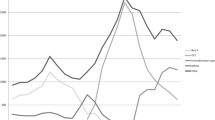Abstract
Introduction and hypothesis
This study was conducted to assess national rates in stress urinary incontinence (SUI) surgery in the USA from 1998 to 2007.
Methods
We utilized the 1998–2007 Nationwide Inpatient Sample and assessed women aged 20 years and older who underwent SUI surgery based on the International Classification of Diseases, 9th Revision (ICD-9) procedure and diagnosis codes.
Results
The total number of SUI surgeries performed during this 10-year period was 759,821. The annual number of procedures increased from 37,953 in 1998 to 94,910 in 2007. The type of SUI surgery performed also changed (p < 0.001). In 1998, retropubic suspensions represented 52.3%, decreasing to 13.8% in 2007. “Other repair of SUI” (ICD-9 59.79) comprised 22.4% in 1998, increasing to 75.2% in 2007, likely representing midurethral slings.
Conclusions
The total number and incidence rates of SUI surgeries have increased from 1998 to 2007. The type of SUI surgery performed has also changed significantly, likely secondary to adoption of midurethral slings.


Similar content being viewed by others
References
Nygaard I, Barber MD, Burgio KL, Kenton K, Meikle S, Schaffer J, Spino C, Whitehead WE, Wu J, Brody DJ (2008) Prevalence of symptomatic pelvic floor disorders in US women. JAMA 300:1311–6
Vincent GK, Velkoff VA (2010) The next four decades, the older population in the United States: 2010 to 2050. Current population reports. U.S. Census Bureau, Washington
ACOG (2005) Practice bulletin: urinary incontinence in women. Obstet Gynecol 105:1533–1545
Ward KL, Hilton P (2008) Tension-free vaginal tape versus colposuspension for primary urodynamic stress incontinence: 5-year follow up. Bjog 115:226–33
FDA. 510(K) Number K974098. Jan 28, 1998. http://www.accessdata.fda.gov/scripts/cdrh/cfdocs/cfPMN/pmn.cfm?ID=114995. Accessed 5 Oct 2009
Boyles SH, Weber AM, Meyn L (2003) Procedures for urinary incontinence in the United States, 1979–1997. Am J Obstet Gynecol 189:70–5
Taub DA, Hollenbeck BK, Wei JT, Dunn RL, McGuire EJ, Latini JM (2005) Complications following surgical intervention for stress urinary incontinence: a national perspective. Neurourol Urodyn 24:659–65
Oliphant SS, Wang L, Bunker CH, Lowder JL (2009) Trends in stress urinary incontinence inpatient procedures in the United States, 1979–2004. Am J Obstet Gynecol 200(521):e1–6
Erekson EA, Lopes VV, Raker CA, Sung VW (2010) Ambulatory procedures for female pelvic floor disorders in the United States. Am J Obstet Gynecol 203(5):4971e.1–4971e.5
DeFrances CJ, Podgornik MN (2006) 2004 National Hospital Discharge Survey. Adv Data (371):1–19
HCUP Nationwide Inpatient Sample (NIS). Healthcare Cost and Utilization Project (HCUP). 1998–2007. Agency for Healthcare Research and Quality, Rockville, MD. www.hcup-us.ahrq.gov/nisoverview.jsp
Pietrobon R, Guller U, Martins H, Menezes AP, Higgins LD, Jacobs DO (2004) A suite of web applications to streamline the interdisciplinary collaboration in secondary data analyses. BMC Med Res Methodol 4:29
U.S. Census Bureau (NP-D1-A) Annual projections of the resident population by age, sex, race, and Hispanic origin: lowest, middle, highest series and zero International Migration Series, 1999 to 2100.
Klein RJ, Schoenborn CA (2001) Age adjustment using the 2000 projected U.S. population. Healthy People 2010 Stat Notes (20):1–10
Shah AD, Kohli N, Rajan SS, Hoyte L (2008) The age distribution, rates, and types of surgery for stress urinary incontinence in the USA. Int Urogynecol J Pelvic Floor Dysfunct 19:89–96
DeFrances CJ, Lucas CA, Buie VC, Golosinskiy A (2008) 2006 National Hospital Discharge Survey. Natl Health Stat Report (5):1–20
Nygaard IE, Heit M (2004) Stress urinary incontinence. Obstet Gynecol 104:607–20
Glazener CM, Cooper K (2004) Bladder neck needle suspension for urinary incontinence in women. Cochrane Database Syst Rev: CD003636
Bergman A, Elia G (1995) Three surgical procedures for genuine stress incontinence: five-year follow-up of a prospective randomized study. Am J Obstet Gynecol 173:66–71
Lapitan MC, Cody JD, Grant A (2009) Open retropubic colposuspension for urinary incontinence in women. Cochrane Database Syst Rev: CD002912
Albo ME, Richter HE, Brubaker L, Norton P, Kraus SR, Zimmern PE, Chai TC, Zyczynski H, Diokno AC, Tennstedt S, Nager C, Lloyd LK, FitzGerald M, Lemack GE, Johnson HW, Leng W, Mallett V, Stoddard AM, Menefee S, Varner RE, Kenton K, Moalli P, Sirls L, Dandreo KJ, Kusek JW, Nyberg LM, Steers W (2007) Burch colposuspension versus fascial sling to reduce urinary stress incontinence. N Engl J Med 356:2143–55
Nilsson CG, Kuuva N, Falconer C, Rezapour M, Ulmsten U (2001) Long-term results of the tension-free vaginal tape (TVT) procedure for surgical treatment of female stress urinary incontinence. Int Urogynecol J Pelvic Floor Dysfunct 12(Suppl 2):S5–8
Ward K, Hilton P (2002) Prospective multicentre randomised trial of tension-free vaginal tape and colposuspension as primary treatment for stress incontinence. BMJ 325:67
Lee J, Dwyer PL (2010) Age-related trends in female stress urinary incontinence surgery in Australia—Medicare data for 1994–2009. Aust N Z J Obstet Gynaecol 50:543–9
Cammu H, Saeys F, Haentjens P (2010) Dramatic increase (1997–2007) in the number of procedures for stress urinary incontinence in Belgium. Int Urogynecol J Pelvic Floor Dysfunct 21:1511–5
Wu MP, Huang KH, Long CY, Tsai EM, Tang CH (2010) Trends in various types of surgery for hysterectomy and distribution by patient age, surgeon age, and hospital accreditation: 10-year population-based study in Taiwan. J Minim Invasive Gynecol 17:612–9
Sung VW, Weitzen S, Sokol ER, Rardin CR, Myers DL (2006) Effect of patient age on increasing morbidity and mortality following urogynecologic surgery. Am J Obstet Gynecol 194:1411–7
Acknowledgments
The authors thank Ricardo Pietrobon and “Research on Research” team, Duke University Health System (Jan 27, 2009, http://researchonresearch.org/).
Conflicts of interest
None.
Author information
Authors and Affiliations
Corresponding author
Rights and permissions
About this article
Cite this article
Wu, J.M., Gandhi, M.P., Shah, A.D. et al. Trends in inpatient urinary incontinence surgery in the USA, 1998–2007. Int Urogynecol J 22, 1437–1443 (2011). https://doi.org/10.1007/s00192-011-1509-x
Received:
Accepted:
Published:
Issue Date:
DOI: https://doi.org/10.1007/s00192-011-1509-x




